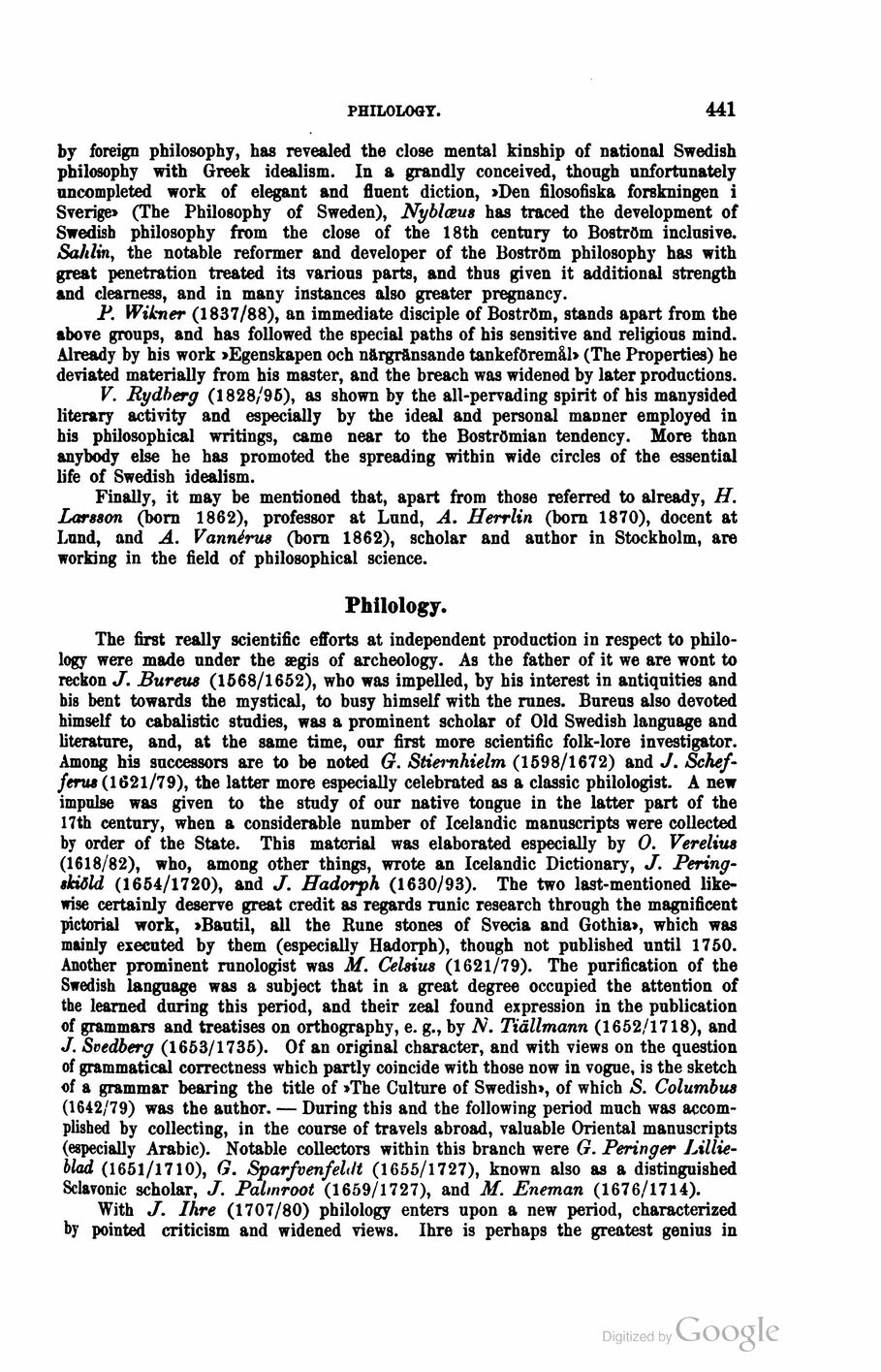
Full resolution (JPEG) - On this page / på denna sida - First part - IV. Education and Mental Culture - 10. Science - Philosophy, by Prof. V. Norström, Ph. D., Gothenburg - Philology, after Docent O. von Friesen, Ph. D., Uppsala, and E. J. Ljunggren, Ph. D., Librarian, Lund

<< prev. page << föreg. sida << >> nästa sida >> next page >>
Below is the raw OCR text
from the above scanned image.
Do you see an error? Proofread the page now!
Här nedan syns maskintolkade texten från faksimilbilden ovan.
Ser du något fel? Korrekturläs sidan nu!
This page has never been proofread. / Denna sida har aldrig korrekturlästs.
PHILOLOGY.
441
by foreign philosophy, has revealed the close mental kinship of national Swedish
philosophy with Greek idealism. In a grandly conceived, though unfortunately
uncompleted work of elegant and fluent diction, »Den filosofiska forskningen i
Sverige» (The Philosophy of Sweden), Nyblceus has traced the development of
Swedish philosophy from the close of the 18th century to Boström inclusive.
Sahlin, the notable reformer and developer of the Boström philosophy has with
great penetration treated its various parts, and thus given it additional strength
and clearness, and in many instances also greater pregnancy.
P. Wikner (1837/88), an immediate disciple of Boström, stands apart from the
above groups, and has followed the special paths of his sensitive and religious mind.
Already by his work »Egenskapen och närgränsande tankeföremål» (The Properties) he
deviated materially from his master, and the breach was widened by later productions.
V. Rydberg (1828/95), as shown by the all-pervading spirit of his manysided
literary activity and especially by the ideal and personal manner employed in
his philosophical writings, came near to the Boströmian tendency. More than
anybody else he has promoted the spreading within wide circles of the essential
life of Swedish idealism.
Finally, it may be mentioned that, apart from those referred to already, H.
Larsson (born 1862), professor at Lund, A. Herrlin (born 1870), docent at
Lund, and A. Vannérus (born 1862), scholar and author in Stockholm, are
working in the field of philosophical science.
Philology.
The first really scientific efforts at independent production in respect to
philology were made under the aegis of archeology. As the father of it we are wont to
reckon J. Bureus (1568/1652), who was impelled, by his interest in antiquities and
his bent towards the mystical, to busy himself with the runes. Bureus also devoted
himself to cabalistic studies, was a prominent scholar of Old Swedish language and
literature, and, at the same time, our first more scientific folk-lore investigator.
Among his successors are to be noted G. Stiernhielm (1598/1672) and J.
Schef-ferus (1621/79), the latter more especially celebrated as a classic philologist. A new
impulse was given to the study of our native tongue in the latter part of the
17th century, when a considerable number of Icelandic manuscripts were collected
by order of the State. This material was elaborated especially by 0. Verelius
(1618/82), who, among other things, wrote an Icelandic Dictionary, J.
Pering-tkiöld (1654/1720), and J. Hadorph (1630/93). The two last-mentioned
likewise certainly deserve great credit as regards runic research through the magnificent
pictorial work, »Bautil, ail the Rune stones of Svecia and Gothia», which was
mainly executed by them (especially Hadorph), though not published until 1750.
Another prominent runologist was M. Celsius (1621/79). The purification of the
Swedish language was a subject that in a great degree occupied the attention of
the learned during this period, and their zeal found expression in the publication
of grammars and treatises on orthography, e. g., by N. Tiållmann (1652/1718), and
J. Svedberg (1653/1735). Of an original character, and with views on the question
of grammatical correctness which partly coincide with those now in vogue, is the sketch
of a grammar bearing the title of »The Culture of Swedish», of which S. Columbus
(1642/79) was the author. — During this and the following period much was
accomplished by collecting, in the course of travels abroad, valuable Oriental manuscripts
(especially Arabic). Notable collectors within this branch were G. Peringer
Lxllie-blad (1651/1710), G. Sparfvenfeldt (1655/1727), known also as a distinguished
Sclavonic scholar, J. Palmroot (1659/1727), and M. Eneman (1676/1714).
With J. Ihre (1707/80) philology enters upon a new period, characterized
by pointed criticism and widened views. Ihre is perhaps the greatest genius in
<< prev. page << föreg. sida << >> nästa sida >> next page >>